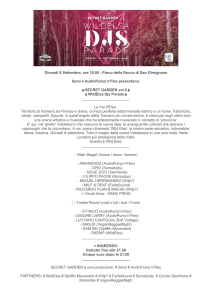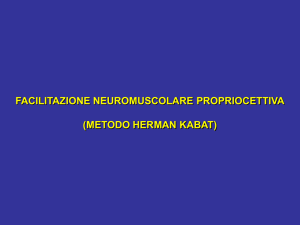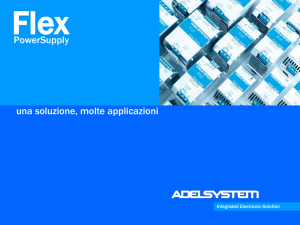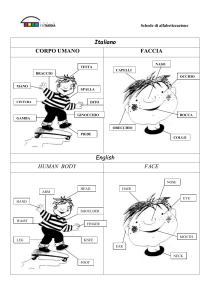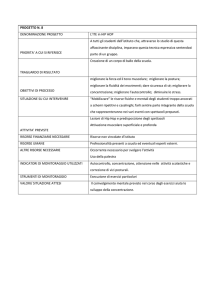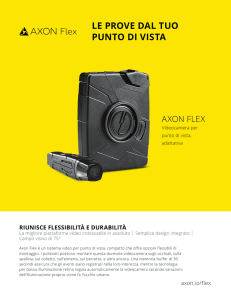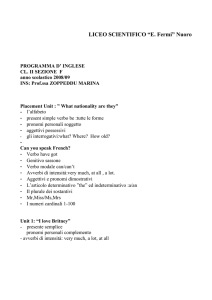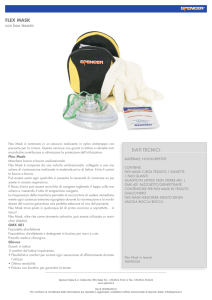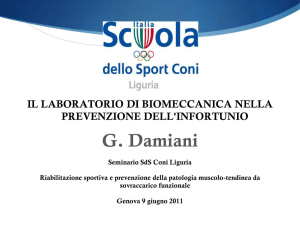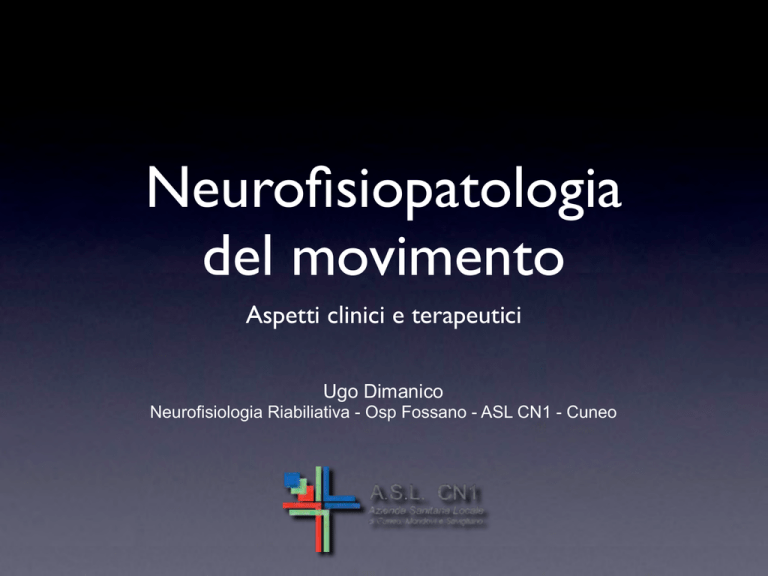
Neurofisiopatologia
del movimento
Aspetti clinici e terapeutici
Ugo Dimanico
Neurofisiologia Riabiliativa - Osp Fossano - ASL CN1 - Cuneo
•
•
•
•
•
cenni anatomici
vie motorie
spasticità - UMS
clinica
•
•
•
•
stroke
PCI
lesione midollare
SLA
Gait Analysis
cenni anatomici
SISTEMA NERVOSO CENTRALE - SNC
Encefalo
emisferi
tronco cerebrale
mesencefalo
ponte
bulbo
Midollo spinale
SISTEMA NERVOSO
PERIFERICO
12 nervi cranici
origine dal tronco cerebrale
33 nervi spinali
origine dal midollo spinale
Gli emisferi cerebrali sono
divisi in lobi
I lobi sono formati da CIRCONVOLUZIONI
AREE CEREBRALI
Tronco cerebrale
Suddiviso in:
•mesencefalo
•ponte
•bulbo
Composto da:
Vie ascendenti da midollo/cervelletto
a emisferi
Vie discendenti da emisferi a
midollo/cervelletto
origine dei 12 nn. Cranici
Formazione reticolare
Cervelletto
Situato posteriormente
al tronco
Comprende:
corteccia
sostanza bianca
nuclei
Connesso con:
emisferi
midollo
orecchio interno (vestibolo)
MIDOLLO SPINALE
Neurone - assone - mielina
Emisferi: sostanza grigia e bianca
Emisferi: sostanza grigia e bianca
VASCOLARIZZAZIONE
L’encefalo riceve il sangue da:
carotide interna (2/3 anteriori di emisferi)
vertebrale (1/3 posteriore di emisferi, tronco e cervelletto)
Poligono del Willis
Alla base dell’encefalo il
poligono di Willis
“redistribuisce” il sangue
I rami terminali sono:
arteria cerebrale anteriore
arteria cerebrale media
arteria cerebrale posteriore
vie motorie
Vie Motorie
nuclei della base
corteccia motoria
I motoneurone
Midollo spinale
(corna anteriori)
II motoneurone
muscolo
cervelletto
riflessa
avviene senza il controllo della volontà
MOTILITA’
automatica
avviene con il parziale controllo della volontà
volontaria
avviene con il completo controllo della volontà
I tre tipi di M. richiedono livelli di organizzazione progressivamente
superiori:
M. riflessa: midollo spinale
M. automatica: strutture sottocorticali
M. volontaria: corteccia cerebrale
Motilità riflessa
circuiti intrinseci
al midollo spinale
Lesione sistema di coordinazione cerebellare
Sintomo: assenza/riduzione di coordinazione
atassia
dismetria
disartria
Lesione sistema extrapiramidale
Sintomo: difficoltà nel controllo e nello svolgimento
del movimento
bradicinesia
acinesia
discinesie
tremore
Lesione sistema piramidale
Paresi centrale
Paresi periferica
Ipertonica
Ipotonica
Iperreflessica
Iporeflessica
Estensione plantare
Flessione plantare
Ipotrofica
Motilità e sede di lesione
Encefalica: emiparesi
Midollare: paraparesi o tetraparesi
Periferica: paresi di muscoli innervati dal nervo leso
Sensibilità e sede lesionale
Encefalica: emiipoestesia/anestesia
Midollare: ipo/anestesia distale al livello di lesione
Periferica: ipo/anestesia nel territorio cutaneo
dipendente dal nervo leso
la spasticità -UMS
La spasticità - la definizione
aumento velocita’-dipendente del riflesso tonico da stiramento
(tono muscolare)
con aumento dei riflessi osteo-tendinei per la ipereccitabilita’
del riflesso da stiramento,
parte della sindrome del motoneurone superiore (Lance 1980)
La spasticità - il sintomo
incapacità a rilassare adeguatamente il muscolo, che resta
contratto, opponendosi ai movimenti volontari: “congelamento”
Avvertito dal Paz. come “rigidità”, “pesantezza”, ...
Sindrome del motoneurone superiore UMS
30
Analisi del movimento
ruolo in clinica
• tossina botulinica
• chirurgia funzionale
• pompe al baclofen
• definizione programma riabilitativo
Setting Goals of Treatment
No meaningful plan can be formulated
without first determining the goals of
treatment including:
patient/caregiver goals
functional goals
www.wemove.org
Possible Treatment Goals
•
Increased ROM
•
Improved mobility
•
Decrease energy
expenditure
•
Improved gait
•
Improved orthotic fit
•
Improved positioning
•
Increased ease of
hygiene
•
Improved cosmesis
•
Decreased spasm
frequency
•
Decreased pain
Pattern nella UMS
Equinovarus
equinovalgus
stiff knee
adducted thighs
flexed knee
flexed hip
hyperextension great toe
34
Common Clinical Patterns: Lower Limbs
35
Equinovarus foot
•
gastrocnemius medial/lateral
•
soleus
•
tibialis posterior
•
tibialis anterior
•
flexor digitorum longus
•
flexor digitorum brevis
•
flexor hallucis longus
Striatal toe
•
37
extensor hallucis longus
Adducted thighs
38
•
adductor magnus
•
adductor longus
•
adductor brevis
Flexed Knee
39
•
medial hamstrings
•
lateral hamstrings
•
gastrocnemius
Extended knee
•
•
40
quadriceps
retto femore
Pattern nella UMS
Piede equino - varo
- supinato:
TP
in sinergia con
TA
41
Pattern patologici aa sup.
42
Gait analysis: esempi clinici
Iperattivazione TA sin
Post trattamento TA
TA
GM
PL
44
Ipoattivazione TA: stimolatore peroneale
45
Attivazione tonica TA e TP
riposo
TA
TP
SOL
TA
SOL
46
Ipoattivazione lato paretico
47
Emi destra: Iperattività loggia posteriore gamba
48
Paraparesi spastica
Baclofen IT: 30 microgr
50 microgr
49
Clono nella fase di stance
50
Emiparesi dx:
attivazione tonica TA
ipoattivazione soleo (retrazione)
dx
ta
sol
sin
ta
sol
51
The Spasticity Management Team
•
•
•
•
•
•
•
Neurologist
Physiatrist
Neurosurgeon; orthopedic surgeon
PT and OT
Family and other caregivers
Coordinator/administrator
Wheelchair clinic, gait lab, orthotics clinic,
counseling, social work
Ictus
ICTUS Cerebrale
• abolizione improvvisa di alcune funzioni cerebrali, di
origine vascolare, caratterizzato di solito da paralisi
ed emiplegia
• III causa di morte
• 70 % ischemico: rammollimento
• 12% emorragia
• III causa di morte - I causa disabilità
tipi di stroke
•
mettere stroke diagram
emorragico
ischemico
RAMMOLLIMENTO CEREBRALE (INFARTO)
Metabolismo ossidativo
Glucosio (ossigeno)
• Encefalo:
– 2% peso ~ 25% del consumo globale 02
– 50 cc sangue/100 grammi tessuto/minuto
• 8-10" pdc
• 4-8' lesioni irreversibili
REGOLAZIONE FLUSSO
ARTERIOSO CEREBRALE
• 1) pressione sistemica
Flusso
∝ Pressione/Resistenze vasali
• 2) autoregolazione vasale
– ↑P = ↓ Ø
– ↓ P = ↓ Ø (fino a 60 mm Hg)
• 3) barocettori seno carotideo e arco aortico
• 4) regolazione biochimica
– ↑P O2 / ↓ PCO2= ↓Ø
– ↓P O2 / ↑ PCO2 = ↑Ø
Autoregolazione vasale
•
mettere autoreg vasale
ARTERIOSCLEROSI
• aumento resistenze
vascolari
• perdita autoregolazione
vasale (rigidità. vasale)
• rigidità barocettori
(sbalzi pressori)
• placche fonte di emboli
• Occlusione arteriosa (2/3)
– Trombosi
• Ateromatosi
• arteriti
– embolie
• cardiopatie
• ateromasia
• grassi
• gassosi
• senza occlusione (1/3)
– ↓ pressione
COFATTORI
• collaterali (Willis)
• pompa cardiaca
• coagulopatie
TIA
attacco ischemico transitorio, focale
• regressione in 24 ore
• possibile recidiva e/o evoluzione in
stroke
• eziologia
– emboligena (da placche al collo e
lisi successiva)
– emodinamica (cofattori)
– spasmo (crisi ipertensiva)
angiografia cerebrale
Placche aterosclerosi (grossi
vasi del collo)
• Omogenee
• disomogenee (emboli)
EMORRAGIA CEREBRALE
• capsulare (a sede tipica)
• emorragia cerebro-meningea
• emorragie circoscritte
(cervelletto, tronco, talamo)
EMORRAGIA CEREBRALE CAPSULARE
•
•
•
esordio
–
fattori scatenanti (ipertensione, sforzi, sole)
–
esordio acuto con pdc → COMA
–
talora prodromi: cefalea, vomito, obnubilamento
alterazioni neurovegetative
–
respiratorie
–
cardiovascolari temperatura
–
trofiche cutanee (anche precoci)
quadro neurologico
–
coma
–
emiplegia ("fuma la pipa")
–
irrequietudine motoria
–
ipertonia generalizzata (decerebrazione)
RAMMOLLIMENTO
fattori predisponesti
EMORRAGIA
fattori scatenanti
preceduto da TIA
ingravescenza progressiva
esordio acuto
non pdc
coma
ipertono precoce
negativismo motorio
≠ neurovegetative
Sindromi cerebrali
•
•
•
•
carotide interna – comune
•
cerebrale media
–
emiplegia fbc
–
superficiale
–
emianestesia
–
afasia globale
–
emiplegia f.b.
–
agnosia
–
afasia motoria Brocà
•
cerebrale anteriore
•
anteriore
posteriore
–
monoplegia crurale
–
emiaestesia
–
≠ psichiche / sfinteriche
–
afasia sensitiva Wernicke
–
≠ neurovegetative
–
astereognosia
cerebrale posteriore
–
profondo
–
art. occipitale
–
–
art. talamo - genicolata
s. algica talamica
•
vertebro-basilari
•
sindr. alterne tronco
emianopsia lat. omonima
emianestesia
Lesioni del MIDOLLLO SPINALE
Lesione sistema piramidale
Paresi centrale
Paresi periferica
Ipertonica
Ipotonica
Iperreflessica
Iporeflessica
Estensione plantare
Flessione plantare
Ipotrofica
Malattia del Motoneurone
Sclerosi laterale amiotrofica - SLA
•
most common neurodegenerative disease of
the motor neuron system.
•
affects motor neurons at 2 or more levels
supplying multiple regions of the body.
•
lower motor neurons in the anterior horn
of the spinal cord and in the brain stem;
•
corticospinal upper motor neurons in the
precentral gyrus;
•
prefrontal motor neurons involved in
planning (atrophy).
•
Loss of lower motor neurons : progressive
muscle weakness and wasting (atrophy).
•
Loss of corticospinal upper motor neurons:
stiffness (spasticity), abnormally active
reflexes, and pathological reflexes.
•
Loss of prefrontal neurons: cognitive
impairment, frontotemporal dementia.
GAIT ANALYSIS
General remarks
GA as MEASUREMENT TOOL
•
GA should be thought as a mesurement tool.
•
It provides useful information about the intricacies of the
normal gait, as well as about how far the individual’s walking
pattern deviates from normal
•
However it does not provide a recipe for treatment. That
information lies solely within the knowledge base of the
investigator who is using the data.
INTERPRETATION IN CONJUNCTION:
•
Medical history
•
physical examination
• lever arm disfunction
• muscle strength, contracture
• body balance, sensitive deficit
•
appropriate imaging
•
slow motion
COPING RESPONSE
•
Individuals with abnormal cerebral control, muscle contractures and leverarm dysfunction are forced to introduce other abnormalities
into the gait to compensate or “cope”with the problem imposed on
them by they condition.
•
This coping response maybe sometimes as simple as vaulting on the less
involved side to compensate for a drop foot in swing.
In severe hemiplegia coping responses may alter gait greatly, furthermore
they frequently occur in different planes.
•
Sorting this out with gait analysis is difficult, but without gait analysis it is
nearly impossible.
HIP FLEXOR MUSCLES
•
ileopsoas: proc trasv T12/L5 - piccolo
trocantere
•
sartorio: SIAS - sup med tibia prox
•
tensore fascia lata: SIAS - iliotibial
band - tubercolo lat tibia
•
retto femorale: SIAI - tendine rotuleo
•
adduttore lungo: sup ant corpo pube
- terzo centrale linea aspra femore
•
pettineo: linea pettinea ramo sup
pube - linea pettinea spirale sup. post
femore
HIP ADDUCTOR
superficiale:
• pettineo: linea pettinea ramo sup pube - linea pettinea spirale sup. post femore
• adduttore lungo: sup ant corpo pube - III centrale linea aspra femore
• gracile: corpo/ramo inf pube - sup med prox tibia
medio
• adduttore breve: ramo inf pube - III prox linea aspra femore
profondo
• adduttore grande (ant): ramo ischiatico - linea aspra femore (tutta)
MOVIMENTI PURI - ASSOCIATI
ankle
MOVIMENTI PURI
movimento
asse
piano del movimento
dorsi / plantiflessione
medio - lat
sagittale
add / abduzione
verticale
(longit. gamba)
orizzontale
pronazione / supinazione
ant / post
(longit piede)
frontale
plantiflessione
Inversione
dorsiflessione
Eversione
adduzione
supinazione
varismo
abduzione
pronazione
valgismo
MOVIMENTI COMPOSTI
asse di rotazione obliquo
DORSI - PLANTI FLESSIONE
•
asse
rotazione
•
rif.: 90°
•
15°-25°
•
40°-55°
•
acc.: 20°.
Pattern GA
kinetic analysis
Knee Flexion/Extension
60
20
10
50
40
30
-­20
Plan
20
Ext
Ext
0
-­10
10
0
10
20
30
40
50
60
70
80
90
10
-­1.0
Flex
-­0.5
50
60
70
50
60
70
80
-­20
90
10
80
20
90
Plan
10
20
30
40
50
60
70
80
50
60
70
80
90
1.0
90
10
20
30
40
50
60
70
80
90
80
90
Ankle Power Sag
2.0
Gen
Gen
40
Ankle Dors/Plan Moment
Knee Power Sag
2.0
30
0.0
Hip Power Sag
Gen
40
-­10
Nm/kg
Nm/kg
0.0
40
30
0
Dor
Ext
0.0
30
20
0.5
Nm/kg
1.0
20
10
Knee Flex/Ext Moment
Flex
Ext
Hip Flex/Ext Moment
10
20
deg
30
Plantar / Dorsiflexion
Dors
70
40
Flex
50
deg
deg
Flex
Hip Flexion/Extension
1.0
3.0
2.0
0.0
W
W
W
1.0
1.0
0.0
Abs
0.0
Abs
Abs
-­1.0
-­1.0
-­2.0
10
20
30
40
50
60
70
80
90
-­1.0
10
20
30
40
50
60
70
80
90
10
20
30
40
50
60
70
kinetic analysis
Knee Flexion/Extension
60
20
10
50
40
30
-­20
Plan
20
Ext
Ext
0
-­10
10
0
10
20
30
40
50
60
70
80
90
10
-­1.0
Flex
-­0.5
50
60
70
50
60
70
80
-­20
90
10
80
20
90
Plan
10
20
30
40
50
60
70
80
50
60
70
80
90
1.0
90
10
20
30
40
50
60
70
80
90
80
90
Ankle Power Sag
2.0
Gen
Gen
40
Ankle Dors/Plan Moment
Knee Power Sag
2.0
30
0.0
Hip Power Sag
Gen
40
-­10
Nm/kg
Nm/kg
0.0
40
30
0
Dor
Ext
0.0
30
20
0.5
Nm/kg
1.0
20
10
Knee Flex/Ext Moment
Flex
Ext
Hip Flex/Ext Moment
10
20
deg
30
Plantar / Dorsiflexion
Dors
70
40
Flex
50
deg
deg
Flex
Hip Flexion/Extension
1.0
3.0
2.0
0.0
W
W
W
1.0
1.0
0.0
Abs
0.0
Abs
Abs
-­1.0
-­1.0
-­2.0
10
20
30
40
50
60
70
80
90
-­1.0
10
20
30
40
50
60
70
80
90
10
20
30
40
50
60
70
kinetic analysis
Knee Flexion/Extension
60
20
10
50
40
30
-­20
Plan
20
Ext
Ext
0
-­10
10
0
10
20
30
40
50
60
70
80
90
10
-­1.0
Flex
-­0.5
50
60
70
50
60
70
80
-­20
90
10
80
20
90
Plan
10
20
30
40
50
60
70
80
50
60
70
80
90
1.0
90
10
20
30
40
50
60
70
80
90
80
90
Ankle Power Sag
2.0
Gen
Gen
40
Ankle Dors/Plan Moment
Knee Power Sag
2.0
30
0.0
Hip Power Sag
Gen
40
-­10
Nm/kg
Nm/kg
0.0
40
30
0
Dor
Ext
0.0
30
20
0.5
Nm/kg
1.0
20
10
Knee Flex/Ext Moment
Flex
Ext
Hip Flex/Ext Moment
10
20
deg
30
Plantar / Dorsiflexion
Dors
70
40
Flex
50
deg
deg
Flex
Hip Flexion/Extension
1.0
3.0
2.0
0.0
W
W
W
1.0
1.0
0.0
Abs
0.0
Abs
Abs
-­1.0
-­1.0
-­2.0
10
20
30
40
50
60
70
80
90
-­1.0
10
20
30
40
50
60
70
80
90
10
20
30
40
50
60
70
Analisi Dinamica
Caviglia
Clinical case 2 - before treatment
• age50
• ischaemic
stroke 4/08
• right
emiparesis
+ aphasia
before 3/31/2010
after (US guide) 1/12/2011
Treatment [UI]
03/31/2010
07/30/2010
rectus femoris
-
50
tibialis anterior
30
-
soleus
80
70
Gamba III med
n peroneo prof
a tibiale ant
•
tibiale ant
•
est lungo dita
•
peroneo br
•
peroneo lungo
•
flex lungo dita
•
tib post
n peroneo sup
a tibiale post
n tibiale post
a peronea
n cut med polpaccio
•
soleo
•
gastrocn med
•
gastrocn lat
Clinical case: case history
• Age: 28 years
• Cerebral palsy
• Bilateral
lengthening
of achilleus
tendons
(3 years)
• Left ankle
arthrodesis
(10 years)
• Bilateral
lengthening of
ischiocrural
muscles
(17 years)
Kinematics
Gait analysis
EMG, electromyography
Helen Hayes Davis protocol - Kadaba M, J Orthop Res. 1990
Gait analysis
kinematics
kinetics
dynamic EMG
EMG, electromyography
Helen Hayes Davis protocol - Kadaba M, J Orthop Res. 1990
kinematic analysis: normal data
Gage RJ, The Treatment of Gait Problems in Cerebral Palsy 1991
Clinical case: pretreatment kinematic analysis
Pelvic Obliquity
Pelvic Tilt
Pelvic Rotation
Right
50
40
Int
0
Ant
Up
deg
20
10
10
deg
deg
30
0
Left
-­10
-­10
Ext
Post
Down
20
10
-­20
0
10
20
30
40
50
60
70
80
90
10
20
30
40
50
60
70
80
90
10
30
40
50
60
70
80
20
30
40
50
60
70
80
90
10
20
70
80
90
80
90
0
-­10
0
90
90
-­20
10
20
30
40
50
60
70
80
90
10
20
Ankle Dorsi/Plantar
30
40
50
60
Foot Progress Angles
30
Int
20
20
10
10
deg
80
80
Int
30
0
0
-­10
Ext
70
Dors
60
deg
50
Plan
40
60
Ext
Ext
Val
30
50
10
40
-­10
20
40
20
50
10
-­10
30
Knee Rotation
deg
Flex
deg
0
10
20
Knee Flexion/Extension
Var
deg
20
60
10
70
10
Ext
10
20
90
-­10
Knee Ab/Adduction
30
80
0
0
90
70
Int
30
deg
Flex
deg
Add
deg
Abd
Ext
20
60
20
40
-­10
10
50
30
50
10
-­10
40
Hip Rotation
60
0
30
Hip Flexion/Extension
Hip Ab/Adduction
10
20
-­10
-­20
-­20
10
20
30
40
50
60
70
80
90
10
20
30
40
50
60
70
Pelvic Tilt
50
40
Int
Ant
20
10
deg
deg
30
0
-­10
Ext
Post
20
10
-­20
0
10
20
30
40
50
60
70
80
Gage RJ, The identification and treatment of gait problems in cerebral palsy 2009
90
Hip Flexion/Extension
30
Int
50
20
40
30
deg
deg
Flex
60
20
0
Ext
10
Ext
10
0
-­10
-­10
10
20
30
40
50
60
70
80
90
before 9/24/2009
Treatment [UI]
psoas
rectus femoris
after (US guide) 2/14/2011
9/24/2009
6/7/2010
10/11/11
80 left - 80 right
100 left - 100 right
-
-
-
70 left - 70 right
Clinical case: pre-treatment data
test
Right
Left
-10°
- 5°
- 5°/0°
+ 5°/10°
+
+
Hip Extension
- 5°
- 10°
Popliteal angle
- 65°
- 60°
Strength
F4
F4
Ashworth
2
2
Tardieu
Silfverskiöld 0°/90°
Thomas
10 m walk test
0,31 m/s
Clinical case: post-treatment data
test
Right
Left
-10°
- 5°
- 5°/0°
+ 5°/10°
Thomas
+
+
Hip Extension
5°
0°
Popliteal angle
- 65°
- 60°
Strength
F4
F4
Ashworth
2
2
Tardieu
Silfverskiöld 0°/90°
10 m walk test
0,52 m/s
Comparison of spatio-temporal parameters
Walking Speed
Stride Length
Cadence
Single Support
80%
60%
40%
20%
0%
-20%
-40%
09
S
24
e
0
p2
10
18
Ja
0
n2
10
7J
u
0
n2
c
O
11
10
0
t2
14
Fe
0
b2
11
kinematic analysis: normal data
Iliopsoas muscle
vertebra
kidney
psoas
Ward AB, Eur J of Neurol 1999 - Kirchmair L et al. Anesth Analg 2001

